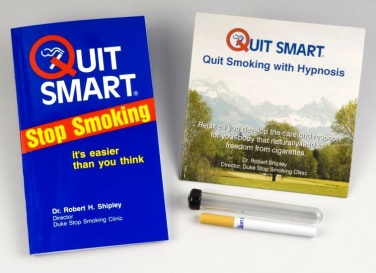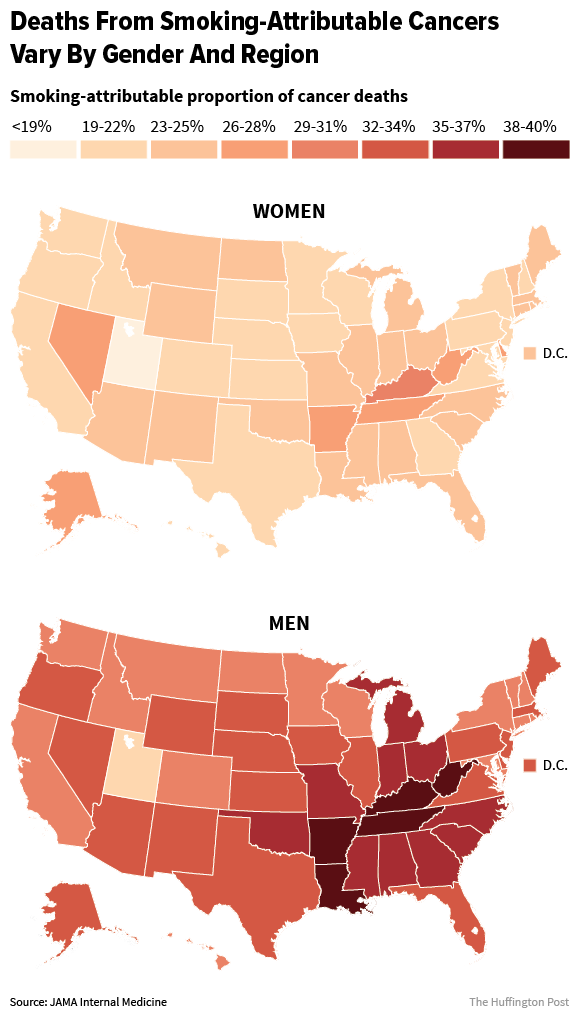Local Smoking Laws Can Make a Huge Difference.
Smoking causes nearly 29 percent of all cancer deaths among Americans over the age of 35, according to a new analysis published in JAMA Internal Medicine. But that doesn’t tell the full story.
Men from the top five southern states are dying at a rate that’s 40 percent higher than the national average.
The higher proportion of cancer deaths attributable to smoking in the South isn’t simply because people in that region smoke more – that distinction goes to the Midwest. Instead, experts say, the lack of funding for tobacco control programs means that there are less resources for people who want to quit, and a permissive public indoor smoking policy signals cultural acceptance for a practice that other states stamped out long ago.
Cancer Deaths Linked to Smoking, by State and Gender
To calculate the rate of cancer deaths from smoking compared to overall cancer deaths, researchers from the American Cancer Society combed through data on 12 cancers caused by cigarette smoking: leukemia, stomach cancer, pancreatic cancer, lung cancer and bladder cancer. Then they calculated the number of smokers in each state and then used both sets of figures to estimate the number of cancer deaths linked to smoking in each state.
In all, at least 167,133 people died from cancer related to cigarette smoking in 2014 – about 27 percent of all cancer deaths in the U.S. that year.
While in most states, only about one-third of cancer deaths in men and one-quarter of cancer deaths in women were attributable to cigarette smoking, the South was different.
Cigarette-smoking men in Arkansas, Louisiana, Tennessee, West Virginia and Kentucky made up nearly 40 percent of all cancer deaths. In women, meanwhile, the highest rate of cancer deaths linked to smoking were in both southern and western states: Kentucky, Arkansas, Tennessee, Alaska and Nevada.
Utah was the state with the lowest rate of deaths attributable to smoking, at 22 percent for men and 11 percent for women. Arkansas had the highest rate for men (40 percent), while Kentucky had the highest rate for women (29 percent). Regionally, they found that heaviest concentration for cancer deaths linked to smoking was concentrated in the South for both men and women.
In total, smoking is linked to an estimated 480,000 deaths per year in the U.S., of which cancer is just one cause. Other fatal conditions include heart disease, stroke, diabetes and lung disease. But because smoking is preventable, and because it makes up a significant portion of the deaths linked to cancer, ACS researchers write in their study that tobacco control should be a major part of the Obama administration’s Cancer Moonshot initiative.
Why Is The South Most Affected?
The South has historically had higher rates of cigarette smoking than the rest of the country for several complex reasons. For one, the region’s low educational attainment and high levels of poverty, both of which are linked to higher rates of smoking, may play a role.
Another reason is that many states in the region are home to tobacco growers who have a lot of political influence in state government. Indeed, 95 percent of U.S. tobacco is grown in the South, according to the ACS researchers.
But southern states also have a political history that makes it even more difficult for state governments to institute research-proven tobacco control policies like high cigarette taxes and comprehensive clean indoor air laws, or invest in educational programs that help adults quit and prevent kids from smoking in the first place, explained Dave Dobbins, chief operating officer of the Truth Initiative, a youth smoking prevention foundation.
“There is a tradition in these states of being resistant to taxation and government intervention in general,” said Dobbins. “That’s part of the character of these states, and I want to make clear that’s not a bad thing. But tobacco is different.”
In contrast, states that have done the most to curb tobacco use through indoor smoking bans and cigarette taxes have the lowest proportion of smoking-related cancer deaths.
California was the first in the nation to ban smoking in indoor workplaces and restaurants in 1995 – a policy they followed up with a 1998 ban on smoking in bars. At the time, these rules were criticized as “draconian” and “unenforceable,” but California persevered and other states eventually followed suit. Just this year, the state raised the smoking age from 18 to 21, making it the second state to do so after Hawaii. California is 49th on the ACS’s list of the proportion of cancer deaths caused by cigarette smoking.
At $4.35 per pack, New York has the highest state cigarette taxes in the nation (the nationwide average is $1.65). It ranks 47th in cancer deaths caused by cigarette smoking.
 Dobbins called it “no accident” that the states with the highest rates of smoking-related cancer deaths were also the states with the weakest anti-smoking regulations. Eight of the 21 states that spend less than 10 percent of the CDC-recommended amount on tobacco control programs are in the South, as are nine of the 14 states with the most relaxed indoor smoking laws.
Dobbins called it “no accident” that the states with the highest rates of smoking-related cancer deaths were also the states with the weakest anti-smoking regulations. Eight of the 21 states that spend less than 10 percent of the CDC-recommended amount on tobacco control programs are in the South, as are nine of the 14 states with the most relaxed indoor smoking laws.
“The states that haven’t done those things are the ones whose citizens are suffering,” said Dobbins. “These cancer deaths are ugly – they cause a lot of pain, they cause a lot of misery, and it’s really bad for the people living there.”
You might also like to read this: What Happens When You Quit Smoking?
Recommended for you: QUIT SMART Kit
Source and References
The Jama Network : http://jamanetwork.com/journals/jamainternalmedicine/article-abstract/2571615
Center For Disease Control and Prevention : https://www.cdc.gov/tobacco/data_statistics/fact_sheets/adult_data/cig_smoking and http://www.cdc.gov/tobacco/data_statistics/fact_sheets/fast_facts
Live Science http://www.livescience.com/8516-smoking-rates-linked-education-cigarette-taxes.html
The Washington Post https://www.washingtonpost.com/news/wonk/wp/2015/01/14/why-the-wealthy-stopped-smoking-but-the-poor-didnt
Health News http://www.npr.org/sections/health-shots/2011/07/14/137843399/smoking-in-california-hits-record-low
The New York Times http://www.nytimes.com/1997/12/31/us/california-s-ban-to-clear-smoke-inside-most-bars.html
LA Times http://www.latimes.com/politics/la-pol-sac-jerry-brown-smoking-bills-20160504-story.html
https://www.tobaccofreekids.org/research/factsheets/pdf/0097.pdf




